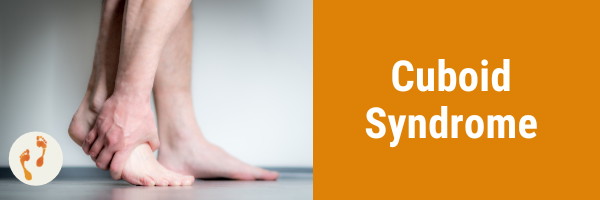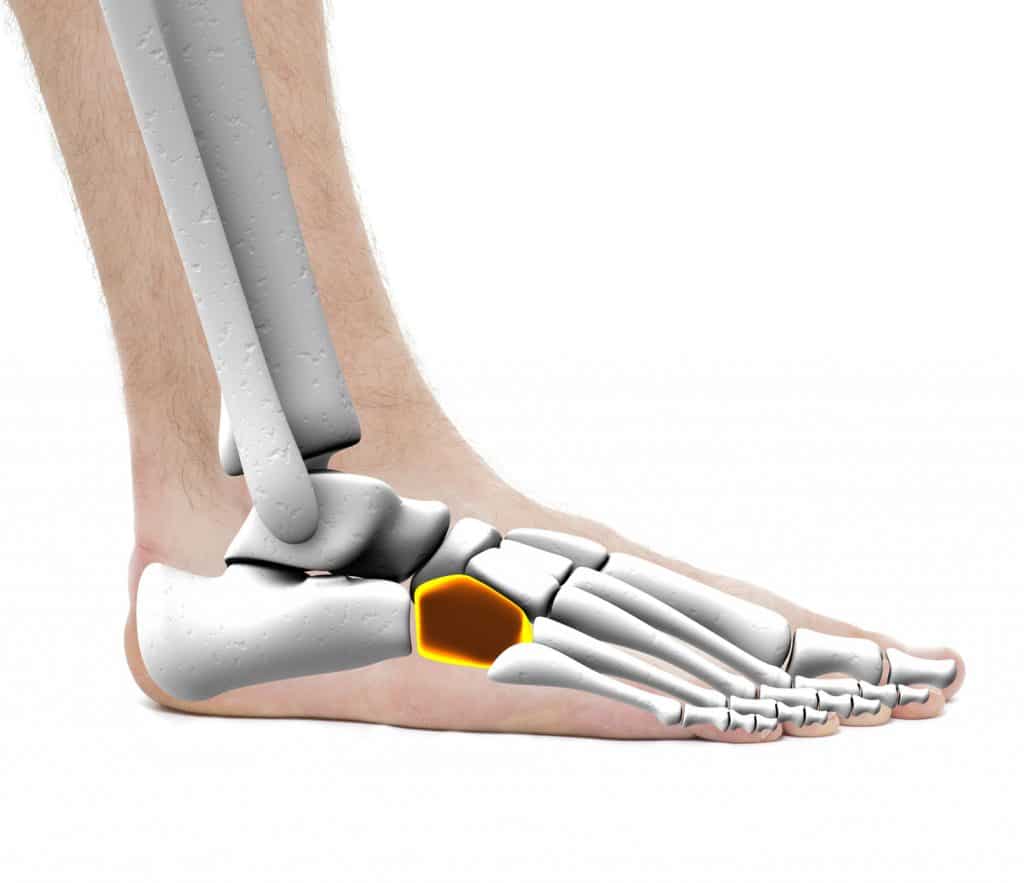
Cuboid syndrome is one of the causes of pain on the outside of the foot, towards the midfoot, that our podiatrists see and treat.
 Having cuboid syndrome means that the ligaments or joints that support your cuboid bone (as pictured) have become damaged. In some cases, this can result in the cuboid becoming partially dislocated. As your cuboid bone is important in helping your foot function efficiently while you walk, cuboid syndrome can produce symptoms including:
Having cuboid syndrome means that the ligaments or joints that support your cuboid bone (as pictured) have become damaged. In some cases, this can result in the cuboid becoming partially dislocated. As your cuboid bone is important in helping your foot function efficiently while you walk, cuboid syndrome can produce symptoms including:
- Pain around the cuboid bone, including at the underside of the foot (though some people have trouble pinpointing the exact location of the biggest pain)
- Pain that can be sharp or dull, and that may come on slowly or quickly
- Pain is worsened when walking or standing, to the point of limping or being unable to bear weight on the injured foot
- Possible swelling or redness in the area of the cuboid
- The pain may radiate to the outside of the ankle
If you’ve developed cuboid syndrome, this may have occurred together with an injury like an ankle sprain, or through overuse and repetitive strain of the peroneus longus muscle (which forms a sling around the cuboid bone, so can place undue tension on it). Your foot biomechanics are also thought to be involved, with a large number of people suffering from cuboid syndrome being found to have flat feet.
Can you fix it?
Yes, our podiatrists can diagnosis cuboid syndrome from your assessment, and work with you to help both reduce your painful symptoms, and repair the problem by:
- Reducing your pain and any inflammation
- Helping to reposition the cuboid in a better alignment
- Creating the right environment for the damage to the ligaments or joints to heal
- Improving your foot biomechanics and function
- Putting the right measures in place to reduce the likelihood of this injury happening again
- Addressing any ankle instability issues that may have caused the cuboid injury
How is cuboid syndrome treated?
Each of our treatments is performed after a comprehensive consultation that uncovers the what’s, how’s and why’s of your cuboid injury. From here, we address every factor that has caused or contributed to your injury, while supporting your foot in healing, repair and pain relief. To do this, we may use:
- Foot mobilisation therapy
- Stretching and strengthening exercises
- Custom foot orthotics
- A review of your footwear
- Strapping
It is not uncommon to find other injuries present at the same time as cuboid syndrome, such as an ankle sprain or a tendinopathy. In these cases, we’ll take additional measures to treat this problem too, which may include using an ankle brace if we find that you have ankle instability that needs more support, or using shockwave therapy for a tendinopathy. We’ll discuss each of your treatment options and how they work during your appointment, as well as recommending which treatment combinations our patients find the greatest success with.
FAQs
Is Cuboid Syndrome a common foot condition?
Cuboid Syndrome isn’t uncommon, but it’s not as common as conditions like metatarsalgia, plantar fasciitis heel pain or Achilles pain. We tend to see it most in those who engage in activities that involve repetitive foot motions or trauma to the foot.
Can Cuboid Syndrome affect one foot or both feet?
Cuboid Syndrome can affect one foot or both feet. It typically occurs on one side, but it can also develop bilaterally in some cases, although this is much less common.
Will I need to modify my activities or restrict weight-bearing during the treatment period?
Modifying activities and temporarily restricting weight-bearing may be necessary during the treatment period to allow the cuboid bone to heal properly – your podiatrist will advise you on this given your specific circumstances. Your podiatrist may recommend avoiding high-impact activities or using supportive footwear or orthotic devices to offload pressure from the affected area.
Are there any specific exercises or physical therapy techniques that can help with the management of Cuboid Syndrome?
Physical therapy may play a role in managing Cuboid Syndrome, it really depends on your symptoms and the severity of your pain. If beneficial, we can guide you through exercises aimed at strengthening the surrounding muscles, improving joint stability, and promoting proper foot mechanics.
Can Cuboid Syndrome be managed or improved without surgery?
Absolutely, Cuboid Syndrome is most often managed without surgery. Surgery is only considered in rare cases when conservative measures fail.
How long does it typically take to recover from Cuboid Syndrome?
The recovery time for Cuboid Syndrome can vary depending on the severity of the condition and the chosen treatment approach. Recovery typically occurs between a few weeks’ to a few months’ time.
Are there any complications or long-term effects associated with Cuboid Syndrome?
With appropriate treatment and management, most individuals with Cuboid Syndrome can experience resolution of symptoms without long-term complications. However, if left untreated or if the condition becomes chronic, it may lead to ongoing pain, instability, or alterations in foot biomechanics, potentially contributing to other foot problems.
Can Cuboid Syndrome recur or become a chronic condition?
Cuboid Syndrome can recur, especially if the underlying causes or contributing factors are not addressed. Additionally, in some cases, if the condition becomes chronic, it may persist or intermittently flare up, requiring ongoing management and preventive measures to minimise your symptoms.
